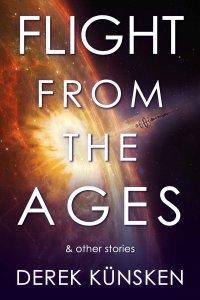Gary K. Wolfe Reviews Comet Weather by Liz Williams
 Comet Weather, Liz Williams (NewCon Press 978-1-912950-46-1, $15.99, 306pp, tp) March 2020.
Comet Weather, Liz Williams (NewCon Press 978-1-912950-46-1, $15.99, 306pp, tp) March 2020.
Comet Weather, Liz Williams’s first novel in several years, is an absolutely lovely tale of an attractive if troubled family in contemporary Somerset and their increasingly hazardous interactions with the world of faerie. I suppose it falls into the broad tradition of what we might call English rural gothic, reaching all the way back through Diana Wynne Jones and Robert Holdstock to Daphne Du Maurier or even Arthur Machen. But Williams is also interested in characters who have to live and work in contemporary Britain, and to balance their lives between their magical heritage and the demands of the real world – much like the characters in Paul Cornell’s recent Lychford series or Graham Joyce’s The Limits of Enchantment. As with those novels, Williams presents us with a family portrait nuanced and intriguing enough to sustain a pretty interesting novel even before the magical ordnance is fully deployed, and indeed the manner in which Williams methodically shifts her tone from domestic magical realism to high-stakes supernatural spectacle – complete with ghosts, time travel, shapeshifting, star-spirits, parallel realities, and even Sir Francis Drake – is a model of narrative management.
Not that she’s coy about showing us the fey connections of the four sisters who are the novel’s central figures. On the very first page, Bee Fallow gets into a conversation with an elder tree, which tells her that her estranged sister Stella will soon be returning to the family home of Mooncote, from which their mother Alys had disappeared a year earlier. Bee, the oldest, has taken over management of the home, and seems the most grounded of the sisters, even though her boyfriend Ned Dark is a 400-year-old Elizabethan ghost. Stella has decamped to the continent, working as a DJ in Ibiza. A third sister, Serena, is a successful fashion designer in London, in a shaky relationship with a rock singer named Ben. The youngest daughter, Luna, has taken up with a sort of countercultural nomadic band following a ritual horse path around England called the Gipsy Switch. All have different fathers, and none know who their father is, but they have fond memories of their astronomer grandfather Abraham, who taught them much about the night sky. With her knowledge of actual astronomy, Williams avoids lapsing into off-the-shelf astrology, but does make use of the old alchemical correspondences of the so-called Behenian stars, any one of whom might show up as a sprite on your doorstep at opportune times. The key astronomical event that gives the book its title is the return, after several thousand years, of Lerninski’s comet, which seems linked in some way to the possible return of the missing mother.
As the daughters return to the family home, preparing for an apple festival, ominous things are already afoot. Ben introduces Serena to a vamp-like Dana Stare, who seems to be plotting to win him away, while Dana’s equally dodgy brother Tam shows up in Somerset as a kind of handyman. Stella is attacked by a huge, black-clad horned figure in her mother’s old room. Serena even has a ghostly conversation with her missing mother, who tells her that she’s been trying to track down a stolen magical family artifact – a bone flute – and that with the comet’s return “things are starting to open up”. The warnings and portents carefully assembled in the first part of the novel begin closing in rapidly in the second section, titled “White Horse Country” – referring to the parallel-world Celtic twilight landscapes that the sisters increasingly encounter. The chapters grow shorter and punchier, the threats creepier, and the stakes much higher. At one point, Bee even finds herself aboard Drake’s famous ship The Golden Hind, revealing that the struggles the family is confronting go back centuries. But while Williams resolves her plot in good folk-fantasy mode, the real and considerable strengths of the novel derive largely from these four fascinating sisters, their mysterious mother, some intriguing secondary characters and villains, and Williams’s own gorgeous, hypnotic prose. Overall, Comet Weather is one of the most affecting and accomplished fantasy novels of the year so far.
Gary K. Wolfe is Emeritus Professor of Humanities at Roosevelt University and a reviewer for Locus magazine since 1991. His reviews have been collected in Soundings (BSFA Award 2006; Hugo nominee), Bearings (Hugo nominee 2011), and Sightings (2011), and his Evaporating Genres: Essays on Fantastic Literature (Wesleyan) received the Locus Award in 2012. Earlier books include The Known and the Unknown: The Iconography of Science Fiction (Eaton Award, 1981), Harlan Ellison: The Edge of Forever (with Ellen Weil, 2002), and David Lindsay (1982). For the Library of America, he edited American Science Fiction: Nine Classic Novels of the 1950s in 2012, with a similar set for the 1960s forthcoming. He has received the Pilgrim Award from the Science Fiction Research Association, the Distinguished Scholarship Award from the International Association for the Fantastic in the Arts, and a Special World Fantasy Award for criticism. His 24-lecture series How Great Science Fiction Works appeared from The Great Courses in 2016. He has received six Hugo nominations, two for his reviews collections and four for The Coode Street Podcast, which he has co-hosted with Jonathan Strahan for more than 300 episodes. He lives in Chicago.
This review and more like it in the April 2020 issue of Locus.
 While you are here, please take a moment to support Locus with a one-time or recurring donation. We rely on reader donations to keep the magazine and site going, and would like to keep the site paywall free, but WE NEED YOUR FINANCIAL SUPPORT to continue quality coverage of the science fiction and fantasy field.
While you are here, please take a moment to support Locus with a one-time or recurring donation. We rely on reader donations to keep the magazine and site going, and would like to keep the site paywall free, but WE NEED YOUR FINANCIAL SUPPORT to continue quality coverage of the science fiction and fantasy field.







